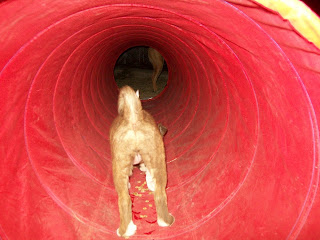Dogs have this same concept of personal space. In a group of dogs, whether intimates or just a gathering at the dog park, personal space is very real. I've had dogs in reactive class that will wait until another dog is within their personal space to snap - before that, the dog is all smiles and wagging tail with many signals of let's meet and maybe play.
How your dog evaluates your ability to control your resources and space can often times, determine whether or not he will listen to you at critical times when you need control of him. If your dog can infringe into your personal space and take something of value like a dog toy you are holding, get on your lap or put his face in your pizza on the coffee table, then your dog’s interpretation is that you cannot control your resources. The consequence of this is that your dog won’t listen to your commands in any other situation.
Puppies have a problem with other's personal space from the beginning. Eventually the adults teach the puppies the value of personal space and what an invitation to come closer is and when it's ok to come closer even without an invitation. But during this learning process, puppies jump and leap and squirm and lick and paw and just cause all sorts of mayhem. In the human world - especialling without an adult dog in household - this behavior largely goes unhandled until the puppy is older, bigger and completely out of control.
This week seems to be the week for dog's with personal space issues. Not their own, but others personal space.
First is Bailey, a 4 year old bulldog mix. Bailey lives with two other dogs, both fairly old, but bonded with each other. Recently Bailey and Guiness started fighting. According to the owners reports, the fights are almost always over space. For instance, Guiness was sniffing a spot on the ground and Bailey came over to check it out as well, invading Guiness' personal space. Guiness takes offense and a fight ensues.
Second is my own dog Storm. Not with me, but with others. A tendency to invade other's personal space I started noticing when she came back from her potential service dog gig. The person she was with loved having Storm climb half way into her lap on the wheel chair, sleep in her bed and just be a lap dog. Now Storm does this to everyone she meets and she is not a small dog - she is 70 lbs of fur.
As a note here, I don't insist my three not jump on guests who come in my house - I live alone, I want people intimidated especially if they come in uninvited. But in the yard, I don't want them being a nuisance to humans or other dogs.
How to teach a dog to respect human personal space.
Method 1:Stand in the middle of a room with something of high value like a stuffed Kong toy. Drop it on the floor behind you and block your dog from getting it. When he finally relaxes and sits, click and treat him. Expand the exercise to other high value items your dog likes – yes, even use cookies if that is relevant to your (and your dogs) situation.
Now here’s the key: Don’t use any command words at all. Just stand there and wait until your dog sits patiently. By not using words or having any emotions in the process of this exercise, your dog begins to react to your body language. Of course your dog must be able to sit.
Method 2:
Start during feeding time and take a piece of the dogs food and put it between your thumb and palm. Your other fingers keep, I assuming the remaining 4, are straight. Call your dog over and when he gets to about 18 inches, push your hand forward so your palm touches his nose. When he stops, give him the piece of dog food. Continue this with his food for three days. When he approaches you in the home give him the stop command, flat palm, sit and then invite him into your personal space. If the dog does come up uninvited and either leans, paws or jumps on you, just walk away and return to your original spot in a few seconds. During the first week of this training the dog will be a bit confused, but the dog will approach, and hesitate. Almost as to ask "May I approach?". This is the goal of the training, to simply have your dog stop and ask if they may approach. Your kids, visitors and people you meet will enjoy this little trick from the dog.
Method 3:
Teach your dog Susan Garrett's "It's Yer Choice" game (explained in Susan's book Ruff Love and there are many video's on YouTube showing how the game is played). Once your dog understands the rules of It's Yer Choice, expand the game to include people, places and other dogs.






























.png)